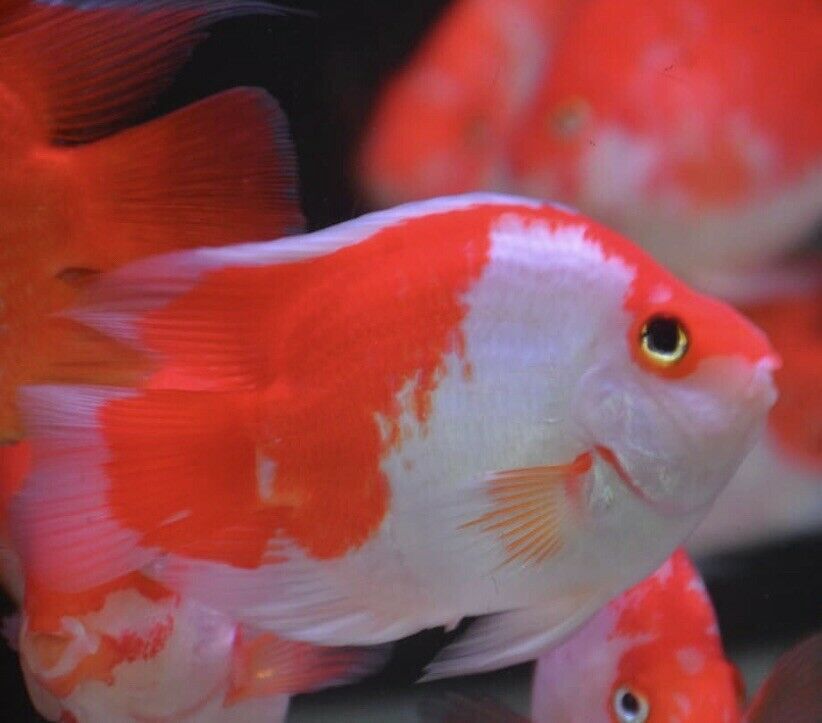Red and White Blood Parrot (Large)
Caring for a Red and White Blood Parrot Cichlid involves maintaining a stable, clean tank environment, proper diet, and understanding their unique behavior and physical traits. Here’s a complete care guide:
Red and White Blood Parrot Cichlid – Overview
-
Type: Hybrid freshwater cichlid
-
Size: 15–20 cm (6–8 inches)
-
Lifespan: 10–15 years (with excellent care)
-
Temperament: Semi-aggressive; social but territorial
-
Color: Bright red and white pattern
Tank Setup
| Parameter | Recommendation |
|---|---|
| Tank Size | Minimum 115 liters (30 gallons) for one; 190+ liters (50+ gallons) for a pair or community |
| Substrate | Sand or smooth gravel |
| Decor | Caves, driftwood, large rocks, plenty of hiding spaces |
| Plants | Use hardy or artificial plants; they may uproot real ones |
| Filtration | Strong and efficient (they are messy eaters) |
| Heater | Yes — maintain 24–28°C (75–82°F) |
| Lighting | Moderate |
Tank Lid is recommended — they may jump when startled.
Water Parameters
| Parameter | Ideal Range |
|---|---|
| Temperature | 24–28°C (75–82°F) |
| pH | 6.5–7.5 |
| Hardness | 6–18 dGH |
| Ammonia/Nitrite | 0 ppm |
| Nitrate | <40 ppm |
| Water Changes | 25–40% weekly due to high waste production |
️ Diet
-
Type: Omnivorous
-
Staple: High-quality cichlid pellets
-
Supplements:
-
Frozen or live foods: bloodworms, brine shrimp
-
Vegetables: peas (deshelled), spinach, zucchini
-
-
Feeding Schedule: 1–2 times per day
-
Avoid: Feeder fish, fatty meats — can cause health issues
Tankmates
Best kept with:
-
Other Blood Parrots
-
Severums
-
Firemouth Cichlids
-
Silver Dollars
-
Plecos (smaller species like Bristlenose)
Avoid:
-
Aggressive cichlids (like Oscars or Jack Dempseys in small tanks)
-
Fin-nippers (Tiger barbs, Serpae tetras)
-
Tiny fish that may get bullied or eaten
Behavior & Enrichment
-
Social and interactive with humans
-
Can be shy; appreciate caves and hiding places
-
Often have deformed mouths, so feeding must be easy to access
-
May display playful or quirky behavior (like rearranging gravel)
Common Health Issues
| Problem | Symptoms | Prevention |
|---|---|---|
| Swim Bladder | Trouble swimming, floating | Avoid overfeeding, feed peas occasionally |
| Bloating | Swollen belly | High-fiber foods, don’t overfeed |
| Ich (White Spot) | White dots on body | Maintain water quality, treat with medication |
Always quarantine new fish and check ammonia/nitrite levels regularly.
Unique Considerations
-
Blood Parrots are man-made hybrids, often with deformities:
-
Small or beak-shaped mouths (can’t fully close)
-
Odd-shaped bodies or spinal curvature
-
-
Some may have faded color over time—enhanced by a good diet
-
Avoid hormone-enhanced foods or dyed fish (unethical and harmful)

